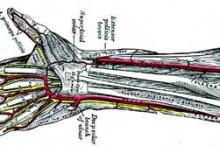User login
Why are American cardiologists so far behind the worldwide curve in performing percutaneous coronary interventions by the radial-artery route?
The degree to which ACS patients suffer needlessly when they undergo percutaneous coronary intervention (PCI) via their femoral artery and not with transradial access was finally, definitively demonstrated in results from the MATRIX Access trial, presented earlier this week at the annual meeting of the American College of Cardiology. The MATRIX results showed in more than 8,000 patients that using a transradial approach for PCI was linked with a statistically significant improvement in 30-day patient survival, a 0.6% absolute difference. For every 167 patients treated by the transradial route, an additional patient lived, compared with similar patients treated with transfemoral access.
The radial approach also cut serious access-site bleeding episodes by an absolute 0.7%, and it was this difference that appeared to mainly drive the difference in patient survival. As study discussant Dr. Roxana Mehran declared from the dais following the MATRIX report, “Bleeding matters! Here is where it’s been proven.”
Results from a second, unrelated trial reported at the meeting, TOTAL, showed that during 2010-2014, in more than 10,000 patients with ST-elevation myocardial infarction treated by PCI in 20 different countries, 68% of patients underwent their procedure via a transradial route.
In contrast, cardiologists I spoke with at the meeting said that recent estimates of PCI use by U.S. interventionalists indicated that they perform roughly 20% of PCIs transradially. That level substantially jumped over the past decade; 10 years ago U.S. transradial use stood at about 3% of all PCIs, my sources said. But 20% still lags woefully behind a worldwide rate of 68%, especially when access site can make a life-or-death difference.
Interventionalists at the meeting also told me some reasons why transfemoral access remains favored. First, it’s the approach many operators first trained in, so they are more familiar and comfortable with it. Second, transradial PCI can take longer, result in higher radiation exposure, and in some patients it’s simply impossible, which means crossover to transfemoral anyway. Finally, transfemoral PCI is just plain easier, they said.
Most of these reasons fall flat when contrasted with causing significantly fewer serious bleeds and improved survival. Of course, when transradial proves impossible there is no choice other than going with transfemoral, but as proponents of transradial said at the meeting, it is a matter of making transradial the initial, default strategy and only resorting to transfemoral when absolutely necessary.
The MATRIX results had another very important finding: To get the best outcomes, centers that offer PCI to acute coronary syndrome patients can’t simply dabble with the transradial approach; they need to be all in. A subanalysis of the MATRIX mortality benefit for transradial procedures showed a striking and statistically significant link between operator commitment to the transradial approach and the ability to give patients a mortality benefit by using the transradial approach. This analysis subdivided the patients into three categories depending on the frequency at which the center where they were treated performed transradial PCI. The three subgroups were centers that did 64% or fewer of their cases transradially, centers that did 65%-79% of their patients transradially, and centers that did 80% or more of their cases via the radial artery.
The data showed that patients treated at centers that used the transradial approach in no more than 64% of their cases actually had a small trend toward better 30-day survival rates when they underwent a transfemoral procedure, although it was not a statistically significant difference. Among the subgroup of patients treated at centers that fell into the middle range of transradial use in everyday practice there was a trend toward better survival with transradial treatment, compared with transfemoral, but again not a statistically significant difference.
It was only among the patients treated at centers that used transradial access nearly all the time, for 80% or more of cases, where transradial use made a statistically significant difference in survival. In this subgroup, patients treated transradially had a 52% relative survival advantage compared with similar patients treated at the same center but via a transfemoral approach.
In other words, when a center in the MATRIX trial did at least 80% of cases with the transradial approach, the patients treated there that way had less than half the 30-day mortality rate, compared with similar patients treated at the same center but by PCI that used a transfemoral approach.
Choosing the PCI access site has moved beyond physician preference and convenience. It’s a matter of patient well-being.
On Twitter @mitchelzoler
Why are American cardiologists so far behind the worldwide curve in performing percutaneous coronary interventions by the radial-artery route?
The degree to which ACS patients suffer needlessly when they undergo percutaneous coronary intervention (PCI) via their femoral artery and not with transradial access was finally, definitively demonstrated in results from the MATRIX Access trial, presented earlier this week at the annual meeting of the American College of Cardiology. The MATRIX results showed in more than 8,000 patients that using a transradial approach for PCI was linked with a statistically significant improvement in 30-day patient survival, a 0.6% absolute difference. For every 167 patients treated by the transradial route, an additional patient lived, compared with similar patients treated with transfemoral access.
The radial approach also cut serious access-site bleeding episodes by an absolute 0.7%, and it was this difference that appeared to mainly drive the difference in patient survival. As study discussant Dr. Roxana Mehran declared from the dais following the MATRIX report, “Bleeding matters! Here is where it’s been proven.”
Results from a second, unrelated trial reported at the meeting, TOTAL, showed that during 2010-2014, in more than 10,000 patients with ST-elevation myocardial infarction treated by PCI in 20 different countries, 68% of patients underwent their procedure via a transradial route.
In contrast, cardiologists I spoke with at the meeting said that recent estimates of PCI use by U.S. interventionalists indicated that they perform roughly 20% of PCIs transradially. That level substantially jumped over the past decade; 10 years ago U.S. transradial use stood at about 3% of all PCIs, my sources said. But 20% still lags woefully behind a worldwide rate of 68%, especially when access site can make a life-or-death difference.
Interventionalists at the meeting also told me some reasons why transfemoral access remains favored. First, it’s the approach many operators first trained in, so they are more familiar and comfortable with it. Second, transradial PCI can take longer, result in higher radiation exposure, and in some patients it’s simply impossible, which means crossover to transfemoral anyway. Finally, transfemoral PCI is just plain easier, they said.
Most of these reasons fall flat when contrasted with causing significantly fewer serious bleeds and improved survival. Of course, when transradial proves impossible there is no choice other than going with transfemoral, but as proponents of transradial said at the meeting, it is a matter of making transradial the initial, default strategy and only resorting to transfemoral when absolutely necessary.
The MATRIX results had another very important finding: To get the best outcomes, centers that offer PCI to acute coronary syndrome patients can’t simply dabble with the transradial approach; they need to be all in. A subanalysis of the MATRIX mortality benefit for transradial procedures showed a striking and statistically significant link between operator commitment to the transradial approach and the ability to give patients a mortality benefit by using the transradial approach. This analysis subdivided the patients into three categories depending on the frequency at which the center where they were treated performed transradial PCI. The three subgroups were centers that did 64% or fewer of their cases transradially, centers that did 65%-79% of their patients transradially, and centers that did 80% or more of their cases via the radial artery.
The data showed that patients treated at centers that used the transradial approach in no more than 64% of their cases actually had a small trend toward better 30-day survival rates when they underwent a transfemoral procedure, although it was not a statistically significant difference. Among the subgroup of patients treated at centers that fell into the middle range of transradial use in everyday practice there was a trend toward better survival with transradial treatment, compared with transfemoral, but again not a statistically significant difference.
It was only among the patients treated at centers that used transradial access nearly all the time, for 80% or more of cases, where transradial use made a statistically significant difference in survival. In this subgroup, patients treated transradially had a 52% relative survival advantage compared with similar patients treated at the same center but via a transfemoral approach.
In other words, when a center in the MATRIX trial did at least 80% of cases with the transradial approach, the patients treated there that way had less than half the 30-day mortality rate, compared with similar patients treated at the same center but by PCI that used a transfemoral approach.
Choosing the PCI access site has moved beyond physician preference and convenience. It’s a matter of patient well-being.
On Twitter @mitchelzoler
Why are American cardiologists so far behind the worldwide curve in performing percutaneous coronary interventions by the radial-artery route?
The degree to which ACS patients suffer needlessly when they undergo percutaneous coronary intervention (PCI) via their femoral artery and not with transradial access was finally, definitively demonstrated in results from the MATRIX Access trial, presented earlier this week at the annual meeting of the American College of Cardiology. The MATRIX results showed in more than 8,000 patients that using a transradial approach for PCI was linked with a statistically significant improvement in 30-day patient survival, a 0.6% absolute difference. For every 167 patients treated by the transradial route, an additional patient lived, compared with similar patients treated with transfemoral access.
The radial approach also cut serious access-site bleeding episodes by an absolute 0.7%, and it was this difference that appeared to mainly drive the difference in patient survival. As study discussant Dr. Roxana Mehran declared from the dais following the MATRIX report, “Bleeding matters! Here is where it’s been proven.”
Results from a second, unrelated trial reported at the meeting, TOTAL, showed that during 2010-2014, in more than 10,000 patients with ST-elevation myocardial infarction treated by PCI in 20 different countries, 68% of patients underwent their procedure via a transradial route.
In contrast, cardiologists I spoke with at the meeting said that recent estimates of PCI use by U.S. interventionalists indicated that they perform roughly 20% of PCIs transradially. That level substantially jumped over the past decade; 10 years ago U.S. transradial use stood at about 3% of all PCIs, my sources said. But 20% still lags woefully behind a worldwide rate of 68%, especially when access site can make a life-or-death difference.
Interventionalists at the meeting also told me some reasons why transfemoral access remains favored. First, it’s the approach many operators first trained in, so they are more familiar and comfortable with it. Second, transradial PCI can take longer, result in higher radiation exposure, and in some patients it’s simply impossible, which means crossover to transfemoral anyway. Finally, transfemoral PCI is just plain easier, they said.
Most of these reasons fall flat when contrasted with causing significantly fewer serious bleeds and improved survival. Of course, when transradial proves impossible there is no choice other than going with transfemoral, but as proponents of transradial said at the meeting, it is a matter of making transradial the initial, default strategy and only resorting to transfemoral when absolutely necessary.
The MATRIX results had another very important finding: To get the best outcomes, centers that offer PCI to acute coronary syndrome patients can’t simply dabble with the transradial approach; they need to be all in. A subanalysis of the MATRIX mortality benefit for transradial procedures showed a striking and statistically significant link between operator commitment to the transradial approach and the ability to give patients a mortality benefit by using the transradial approach. This analysis subdivided the patients into three categories depending on the frequency at which the center where they were treated performed transradial PCI. The three subgroups were centers that did 64% or fewer of their cases transradially, centers that did 65%-79% of their patients transradially, and centers that did 80% or more of their cases via the radial artery.
The data showed that patients treated at centers that used the transradial approach in no more than 64% of their cases actually had a small trend toward better 30-day survival rates when they underwent a transfemoral procedure, although it was not a statistically significant difference. Among the subgroup of patients treated at centers that fell into the middle range of transradial use in everyday practice there was a trend toward better survival with transradial treatment, compared with transfemoral, but again not a statistically significant difference.
It was only among the patients treated at centers that used transradial access nearly all the time, for 80% or more of cases, where transradial use made a statistically significant difference in survival. In this subgroup, patients treated transradially had a 52% relative survival advantage compared with similar patients treated at the same center but via a transfemoral approach.
In other words, when a center in the MATRIX trial did at least 80% of cases with the transradial approach, the patients treated there that way had less than half the 30-day mortality rate, compared with similar patients treated at the same center but by PCI that used a transfemoral approach.
Choosing the PCI access site has moved beyond physician preference and convenience. It’s a matter of patient well-being.
On Twitter @mitchelzoler


